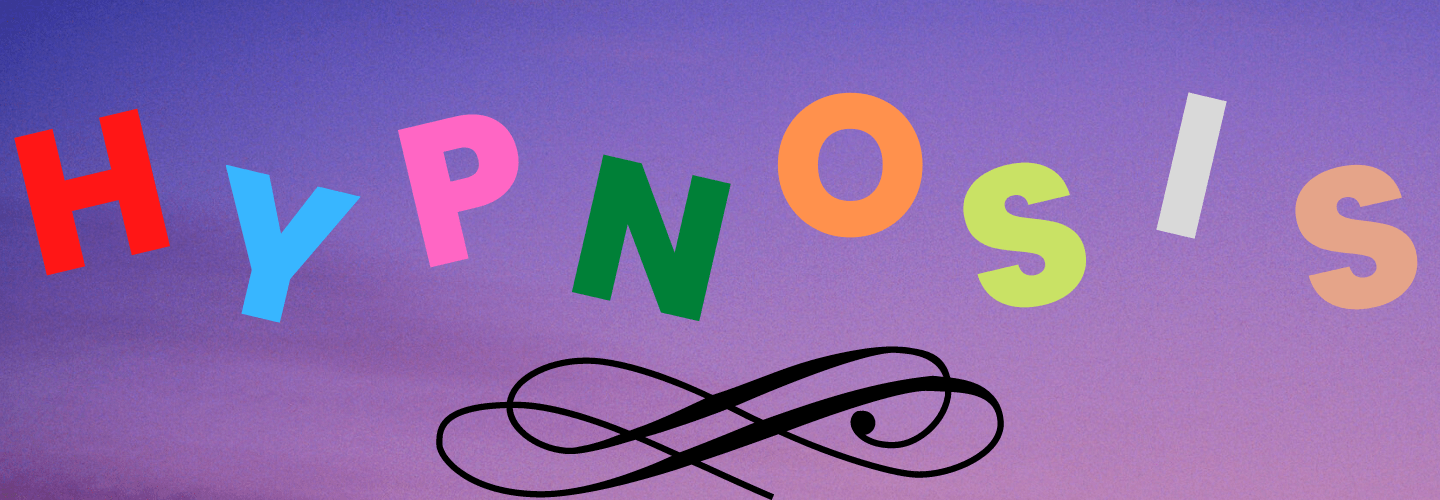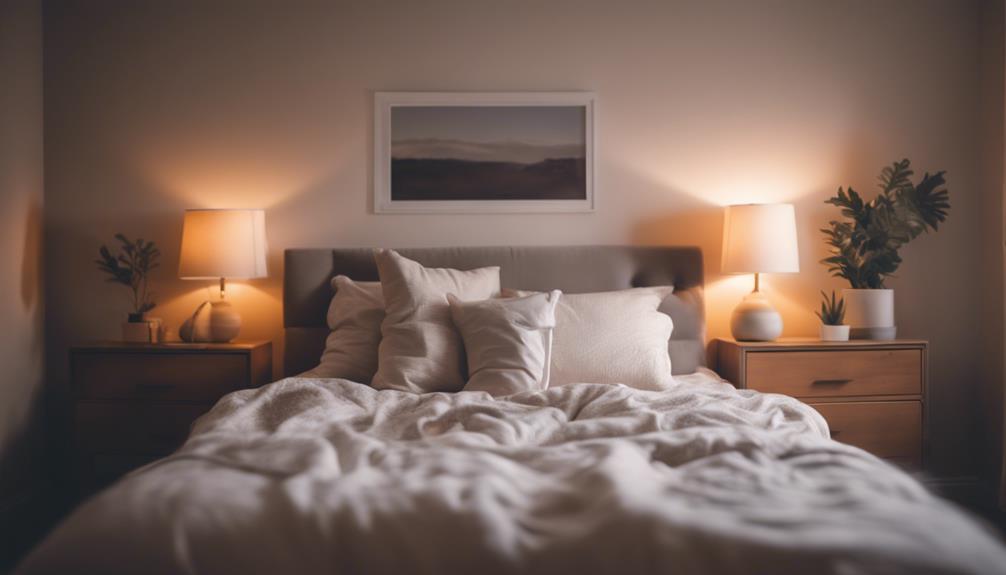
Self-hypnosis techniques like deep breathing, progressive muscle relaxation, and visualization can greatly enhance sleep and give you better sleep quality. By incorporating positive affirmations and guided meditation, one can achieve relaxation and stress relief for better sleep.
Techniques like body scanning and establishing a bedtime routine can also promote relaxation and improved sleep preparation. Anchoring cues and utilizing self-hypnosis scripts further aid in achieving restful sleep. These methods offer effective ways to condition the mind positively for quality rest.
Key Takeaways
- Deep breathing for relaxation and sleep induction.
- Progressive muscle relaxation to release tension.
- Visualization for stress reduction and calmness.
- Positive affirmations for a positive mindset.
- Guided meditation for mindfulness and relaxation.
Deep Breathing Techniques
Utilizing a rhythmic pattern of slow, deep breaths can be an effective self-hypnosis technique to induce relaxation and promote better sleep quality.
Breath control plays an essential role in calming the mind and preparing the body for restful sleep. By focusing on the inhalation and exhalation process, individuals can engage in a form of mindfulness that eases tension and reduces stress levels. This deliberate attention to breathing helps shift the body from a state of alertness to a state of tranquility, signaling to the mind that it is time to unwind.
Mind relaxation is closely linked to breath control during self-hypnosis for better sleep. Deep breathing exercises can activate the body’s relaxation response, slowing down the heart rate and lowering blood pressure. This physiological response encourages a sense of calmness and well-being, paving the way for a more peaceful and uninterrupted night’s rest.
Progressive Muscle Relaxation
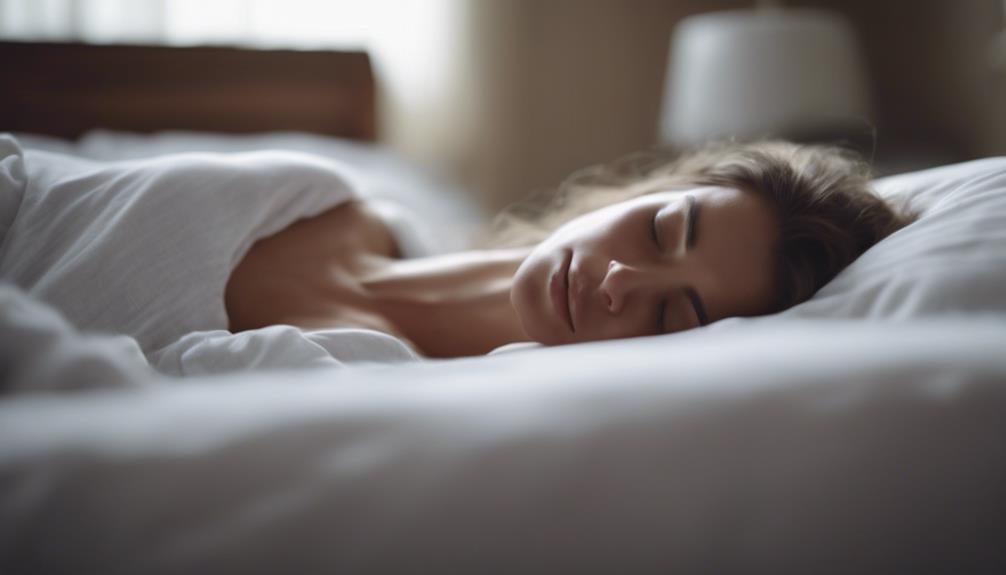
Incorporating progressive muscle relaxation techniques can further enhance the self-hypnosis practice for improving sleep quality by systematically releasing tension and promoting physical and mental relaxation. This method involves tensing specific muscle groups for a few seconds before slowly releasing the tension, allowing for a deep sense of relaxation.
By focusing on each muscle group sequentially, individuals can become more attuned to the sensations of muscle tension and relaxation throughout their body.
Progressive muscle relaxation is particularly effective in reducing muscle tension, a common physical manifestation of stress and anxiety that can interfere with falling asleep. By consciously relaxing the muscles, individuals can trigger what is known as the relaxation response, a state characterized by lower heart rate, decreased blood pressure, and overall calmness.
This technique not only helps in alleviating physical tension but also has a profound impact on the mind, promoting a sense of mental well-being and tranquility conducive to falling asleep easily and achieving better sleep quality.
Visualization and Imagery

Effective self-hypnosis techniques for improving sleep quality often involve the use of visualization and imagery to facilitate relaxation and mental focus. Dream visualization and sleep imagery can be powerful tools in promoting a restful state before sleep. By envisioning calming and peaceful scenes, such as a serene beach or a tranquil forest, individuals can signal to their minds that it is time to unwind and prepare for sleep. This type of visualization can help reduce stress and anxiety, allowing for a smoother shift into sleep.
Emotional visualization and relaxation imagery are also beneficial techniques for enhancing sleep quality. By picturing positive and comforting scenarios, individuals can evoke feelings of safety and comfort, which are conducive to falling asleep easily. Visualizing a place or situation that brings about feelings of happiness and contentment can help shift the focus away from any racing thoughts or worries, promoting a sense of calmness and relaxation that is essential for a good night’s rest.
Positive Affirmations
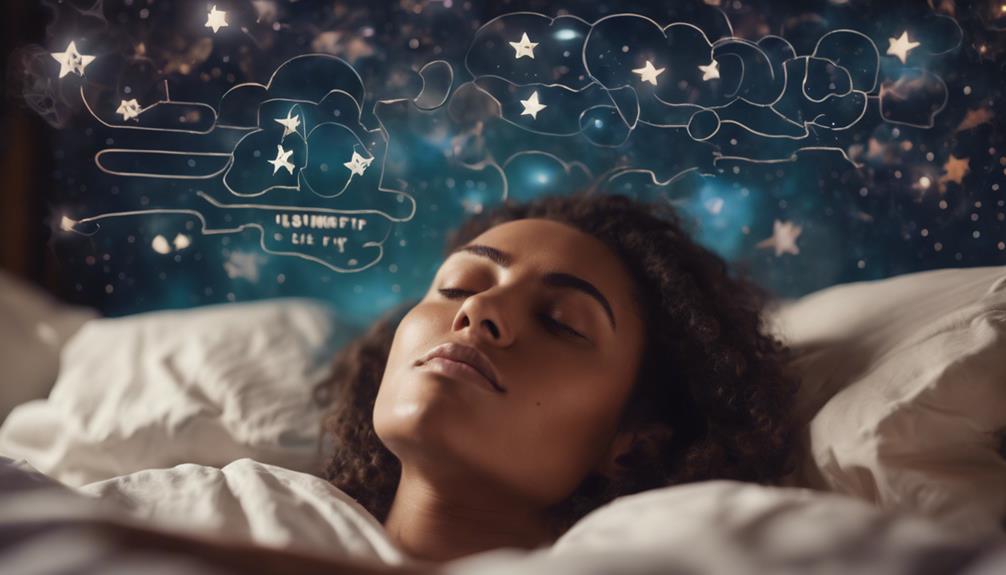
Positive affirmations play an essential role in improving sleep quality by influencing the subconscious mind with empowering statements. Understanding the effectiveness of affirmations and tailoring them to individual needs can enhance their impact on one’s mental state before bedtime.
Integrating personalized affirmations into a nightly routine can help create a positive mindset conducive to restful sleep.
Affirmation Effectiveness Explained
Research has shown that the practice of utilizing affirmations can greatly impact one’s mindset and overall well-being. Positive affirmations offer a range of benefits that are often misconstrued or underestimated.
When tailored to an individual’s needs, affirmations become a powerful tool for enhancing mental health and quality of life. Here are some key points to take into account when exploring the effectiveness of affirmations:
- Affirmations have the potential to rewire negative thought patterns, promoting a more positive outlook on life.
- Customizing affirmations to reflect personal goals and values increases their impact and resonance.
- Regular repetition of affirmations can instill a sense of self-belief and empowerment.
- Affirmations serve as reminders of one’s strengths and capabilities, fostering self-compassion.
- Despite common misconceptions, affirmations are not mere wishful thinking but rather a strategic practice rooted in cognitive psychology.
Crafting Personalized Affirmations
Crafting personalized affirmations involves tailoring positive statements to align with individual values and goals, enhancing their impact on mindset and well-being.
When it comes to affirmation customization for better sleep, personalized mantras play an essential role in promoting relaxation responses within the mind and body. By creating affirmations that resonate with one’s specific needs and desires concerning sleep, individuals can harness the power of positive self-talk to calm the mind and improve sleep quality.
Studies have shown that incorporating personalized affirmations into bedtime routines can lead to significant sleep benefits. Positive affirmations tailored to address concerns such as insomnia, stress, or restless nights can help reframe negative thought patterns and cultivate a more peaceful mindset conducive to sleep.
Integrating Affirmations Into Routine
To optimize the effectiveness of personalized affirmations for improving sleep quality, individuals can establish a routine that integrates these positive self-talk exercises into their daily rituals. Consistency is key when it comes to affirmations, as regular practice reinforces positive beliefs and aids in combating negative thought patterns that can disrupt sleep.
Here are some benefits of integrating affirmations into your routine:
- Boosts Self-Care: Affirmations promote self-care by nurturing self-compassion and fostering a positive self-image.
- Enhances Mental Health: Regularly engaging in affirmations can improve mental health by reducing stress, anxiety, and promoting relaxation.
- Strengthens Resilience: Affirmations build resilience by instilling confidence and a sense of empowerment in facing life’s challenges.
- Cultivates Optimism: By focusing on positive affirmations, individuals can cultivate a more optimistic outlook on life and its challenges.
- Fosters Emotional Well-being: Affirmations contribute to emotional well-being by promoting self-love, acceptance, and inner peace.
Guided Meditation

One effective method for enhancing the practice of self-hypnosis for better sleep quality involves incorporating guided meditation techniques. Guided meditation can be a powerful tool to improve sleep by promoting mindfulness practice and stress relief.
By focusing on calming visualizations and soothing auditory cues during guided meditation sessions, individuals can induce a state of relaxation conducive to falling asleep easily.
Through guided meditation, individuals are encouraged to engage in mindfulness practices that help redirect the mind away from racing thoughts or worries that may interfere with sleep. By immersing oneself in the calming visualizations provided during guided meditation sessions, the mind can be gently guided into a state of tranquility, making it easier to shift into sleep.
This method not only aids in stress relief but also facilitates sleep induction by creating a peaceful mental environment conducive to restful sleep. Incorporating guided meditation into a self-hypnosis routine can remarkably enhance the quality of sleep experienced.
Body Scan Technique
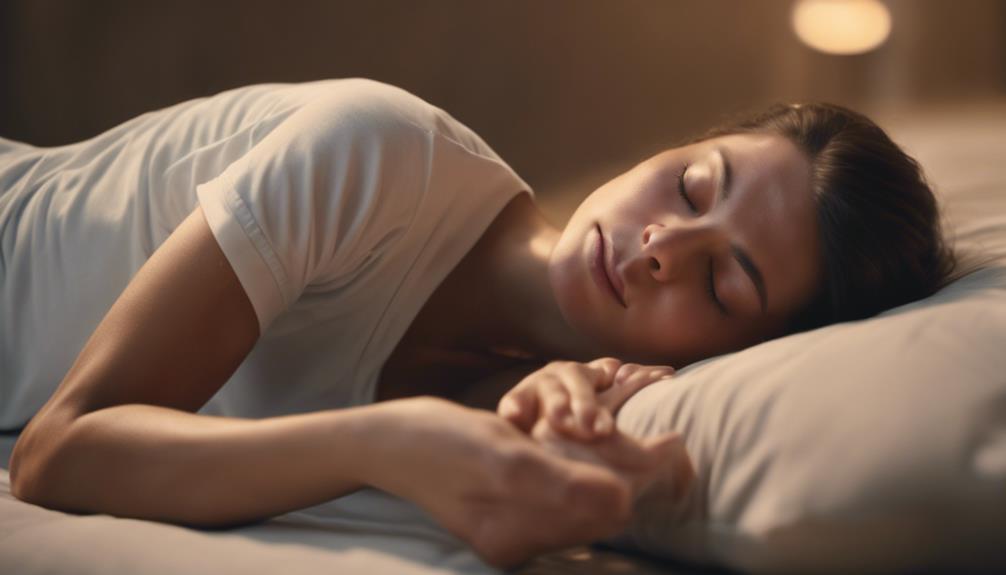
The Body Scan Technique involves systematically focusing on different parts of the body to promote relaxation and enhance the mind-body connection.
By engaging in this practice, individuals can release tension and prepare their bodies for a restful night’s sleep.
This technique has been shown to be effective in calming the mind and improving overall sleep quality.
Relaxing Mind-Body Connection
Exploring the body scan technique can be a valuable tool in enhancing the mind-body connection for improved relaxation and sleep quality. This mindfulness practice involves systematically focusing on each part of your body, helping you become more aware of physical sensations and promoting relaxation.
By incorporating stress reduction techniques like the body scan into your bedtime routine, you can calm the mind and prepare your body for a restful night’s sleep.
- Heightened Awareness: Body scanning fosters a deep connection with your body, allowing you to identify and release tension points.
- Muscle Relaxation: By consciously relaxing each muscle group, you can alleviate physical stress and promote a sense of ease.
- Mindful Breathing: Pairing the body scan with mindful breathing techniques can further deepen relaxation and induce a sense of calm.
- Improved Sleep Quality: Regular practice of the body scan technique has been linked to better sleep quality and overall well-being.
- Stress Reduction: Body scanning is an effective way to unwind from daily stressors, creating a more serene mental state conducive to restful sleep.
Enhancing Sleep Preparation
Utilizing the body scan technique before bedtime can greatly enhance sleep preparation by promoting relaxation and reducing physical and mental tension. This technique involves mentally scanning your body from head to toe, focusing on each body part sequentially to release any tension or stress held within.
By incorporating the body scan into your bedtime routine, you can create a more conducive sleep environment that encourages a state of calmness and tranquility.
In addition to the body scan technique, enhancing sleep preparation also involves establishing healthy bedtime habits. Maintaining a consistent sleep schedule, avoiding stimulants like caffeine close to bedtime, and creating a comfortable and soothing sleep environment are essential practices for improving sleep quality.
A relaxing bedtime routine that includes activities such as reading, meditating, or taking a warm bath can signal to your body that it is time to unwind and prepare for sleep.
Counting Down to Relaxation

Gradually decreasing numbers in a descending sequence is a commonly practiced technique in self-hypnosis to induce a state of relaxation and calmness. This method, known as the sleep countdown, is an effective practice that helps individuals unwind and prepare their minds and bodies for restful sleep. By focusing on counting down from a higher number to zero, individuals can distract themselves from intrusive thoughts, redirecting their attention to the present moment and easing into a state of relaxation.
- Emotionally Engaging Bullet List:
- Peaceful Imagery: Visualizing serene scenes like a tranquil beach or a peaceful forest can enhance the calming effect of the countdown.
- Deep Breathing: Pairing the countdown with deep, slow breaths can amplify the relaxation response in the body.
- Muscle Relaxation: Progressive muscle relaxation while counting down can release tension and promote a deeper sense of calmness.
- Affirmations: Incorporating positive affirmations with the countdown can uplift mood and foster a more positive mindset before sleep.
- Mindfulness: Practicing mindfulness by staying present and focused on the numbers can enhance the efficacy of the relaxation technique.
Anchoring With a Sleep Cue

Establishing a sleep cue is an essential aspect of self-hypnosis techniques for improving sleep quality. By consistently associating a specific cue with the act of falling asleep, individuals can condition their minds to enter a state of relaxation and ease at bedtime.
Repetition plays a pivotal role in reinforcing this association, enhancing the effectiveness of the sleep cue in promoting better sleep.
Cue Establishment
How can one effectively anchor a sleep cue using self-hypnosis techniques for improving sleep quality? Cue establishment, also known as anchoring with a sleep cue, is a powerful method to condition your mind to associate a specific cue with falling asleep easily.
Through hypnotic induction, individuals can create a strong sleep association, signaling the brain that it is time to relax and drift off to sleep.
Here are some key strategies for establishing a sleep cue:
- Visualization: Imagine a peaceful and serene place where you feel completely relaxed.
- Sensory Cues: Use calming scents, such as lavender, or soothing sounds like white noise machines.
- Bedtime Routine: Create a consistent pre-sleep routine to signal to your mind that it is time to unwind.
- Breathing Exercises: Practice deep breathing techniques to promote relaxation and prepare your body for sleep.
- Mindfulness: Engage in mindfulness meditation to clear your mind of racing thoughts and focus on the present moment.
Repetition for Effectiveness
Consistent repetition of the sleep cue in self-hypnosis techniques plays an essential role in anchoring the desired association with improved sleep quality. Through mental rehearsal, individuals can effectively program their subconscious mind to respond positively to the sleep cue, thereby enhancing the effectiveness of the self-hypnosis practice.
By repeatedly exposing the mind to the sleep cue, a strong neural connection is formed, reinforcing the association between the cue and the desired state of relaxation conducive to better sleep.
Incorporating subconscious suggestions during the repetition of the sleep cue can further deepen the impact of self-hypnosis on sleep quality. These suggestions are aimed at influencing the subconscious mind to adopt beliefs and behaviors that support restful sleep, such as letting go of stress and promoting a sense of calmness before bedtime.
The combination of mental rehearsal and subconscious suggestions during the repetition process strengthens the conditioning of the mind towards achieving improved sleep quality through self-hypnosis.
Self-Hypnosis Scripts

Utilizing self-hypnosis scripts can be an effective method for guiding oneself into a state of relaxation and promoting better sleep quality. These scripts often incorporate elements of sleep hygiene and mindfulness practice to enhance their efficacy.
By engaging with self-hypnosis scripts, individuals can create a conducive environment for a restful night’s sleep.
Here are five key benefits of using self-hypnosis scripts for improving sleep quality:
- Enhanced Relaxation: The guided imagery and soothing language in self-hypnosis scripts help in relaxing the mind and body.
- Reduced Stress: Self-hypnosis scripts can aid in reducing stress levels, allowing for a more peaceful shift into sleep.
- Improved Focus: By focusing on the script’s suggestions, individuals can quieten their mind and enhance their ability to concentrate.
- Enhanced Mindfulness: Self-hypnosis scripts often incorporate mindfulness techniques, fostering a greater sense of awareness and presence.
- Better Sleep Quality: Ultimately, the use of self-hypnosis scripts can lead to improved overall sleep quality and a more refreshed feeling upon waking.
Creating a Bedtime Routine

Exploring strategies to enhance sleep quality, establishing a consistent bedtime routine can play a pivotal role in promoting relaxation and preparing the mind and body for a restful night’s rest.
A bedtime routine sets the stage for a peaceful shift from wakefulness to sleep. Incorporating mindful breathing exercises into your routine can help calm the mind and release physical tension accumulated throughout the day. Mindful breathing involves focusing on your breath, taking slow and deep breaths, and being present in the moment.
Additionally, integrating relaxation exercises such as progressive muscle relaxation or visualization techniques can further aid in unwinding before bedtime. Progressive muscle relaxation involves tensing and then relaxing different muscle groups in your body to release tension, while visualization techniques entail imagining serene and tranquil scenes to promote a sense of calm.
Frequently Asked Questions About Better Sleep Quality
How Long Does It Take to See Results From Self-Hypnosis for Better Sleep?
The effectiveness of self-hypnosis on sleep duration varies among individuals. Consistency in practicing self-hypnosis techniques is vital for sustained improvement in sleep quality. Results typically become noticeable within a few weeks of regular self-hypnosis practice.
Can Self-Hypnosis Be Used in Combination With Medication for Sleep?
Self-hypnosis can complement sleep medication by promoting relaxation and reducing anxiety. When used in conjunction with medication, self-hypnosis techniques and meditation can enhance the overall effectiveness of the treatment plan for better sleep quality.
Are There Any Specific Self-Hypnosis Techniques for Different Types of Sleep Disorders?
Various self-hypnosis techniques cater to specific sleep disorders. Insomnia techniques focus on relaxation and visualization. Sleep apnea methods emphasize breathing control. Narcolepsy strategies involve regulating sleep-wake cycles. Restless leg approaches aim to reduce discomfort and promote restful sleep.
Can Self-Hypnosis Help With Recurring Nightmares or Night Terrors?
Self-hypnosis can be a valuable tool in managing anxiety and reducing stress, which are often linked to recurring nightmares or night terrors. By addressing the root cause through self-hypnosis, individuals may experience relief and improved sleep quality.
Is It Possible to Overdo Self-Hypnosis for Sleep and Disrupt Natural Sleep Patterns?
Engaging in excessive self-hypnosis for sleep may pose potential risks by disrupting natural sleep patterns. It is important to strike a balance to avoid adverse effects on sleep quality. Monitoring effectiveness and respecting one’s natural rhythms is paramount.
Conclusion
To wrap up, integrating self-hypnosis techniques into your bedtime routine can markedly enhance sleep quality. By using deep breathing, progressive muscle relaxation, visualization, positive affirmations, guided meditation, counting down to relaxation, anchoring with a sleep cue, and self-hypnosis scripts, individuals can attain a more restful and rejuvenating night’s sleep.
Establishing a consistent bedtime routine that incorporates these techniques can result in a more tranquil and gratifying sleep experience.
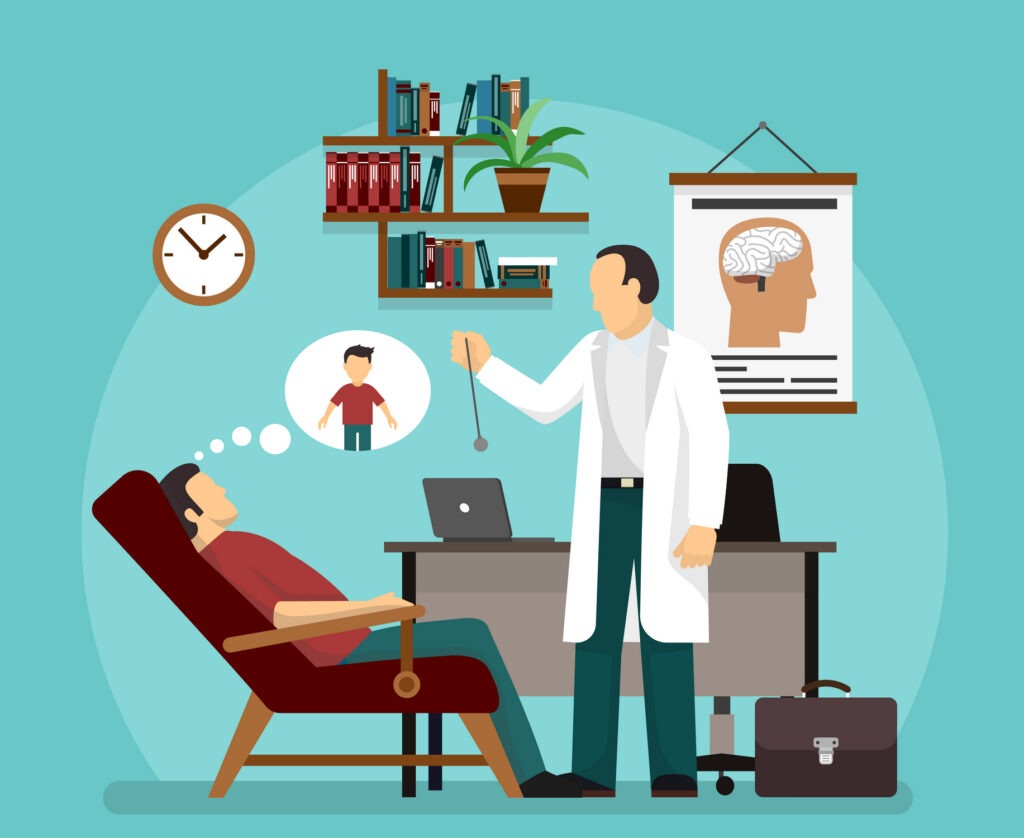
Take the Next Step Make An Appointment
Do not be afraid to reach out to me, Mark , to assist you in any issues you might have. Need a good listener or someone to confidentially talk too? . Life Coaching is 45 minute session, once a week.
Self-Hypnosis is taught in one session, individual sessions or in a group, and lasts a lifetime. Most Hypnotherapy sessions including Age regression last 2 hours and EFT Sessions are usually handled with a one hour session
To make an appointment, first listen to the Pre-talk and fill out the Complementary Healthcare Provider Disclosure. The use the Contact Form to request an appointment with, Mark, The Bohol Hypnosis Expert.
Self-help downloads are available to help you with specific problems. The self-hypnosis program to teach you how to self-hypnotize yourself is available here.

